The automotive powerglide shifters market is estimated to be valued at USD 249.5 million in 2025 and is projected to reach USD 442.6 million by 2035, registering a compound annual growth rate (CAGR) of 5.9% over the forecast period. During the early adoption phase (2020–2024), the market expanded steadily from USD 187.3 million in 2020 to USD 235.6 million in 2024, driven by gradual penetration across performance and specialty vehicles. By 2025, the market will have entered the scaling phase, supported by rising demand across aftermarket channels, competitive motorsports, and high-performance applications that emphasize durability and efficiency.
Between 2025 and 2030, the scaling phase strengthened as the market rose from USD 249.5 million in 2025 to about USD 332.3 million in 2030, indicating accelerated adoption across both OEM and aftermarket usage. By the consolidation phase (2030–2035), the market is projected to expand more moderately, climbing from USD 351.9 million in 2031 to USD 442.6 million in 2035. This indicates a mature stage where competition stabilizes, product differentiation narrows, and replacement demand becomes a larger driver than new adoption. Overall, the maturity curve demonstrates a classic trajectory of steady growth, peak scaling, and eventual consolidation.
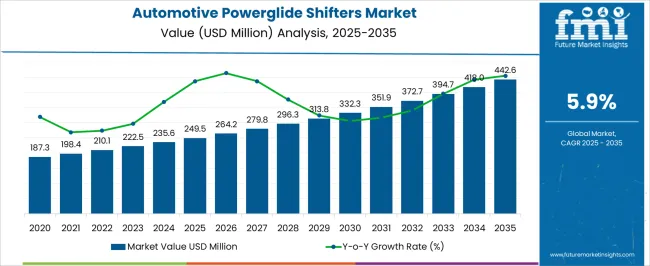
| Metric | Value |
|---|---|
| Automotive Powerglide Shifters Market Estimated Value in (2025 E) | USD 249.5 million |
| Automotive Powerglide Shifters Market Forecast Value in (2035 F) | USD 442.6 million |
| Forecast CAGR (2025 to 2035) | 5.9% |
The automotive powerglide shifters market, valued at USD 249.5 million in 2025 and expected to reach USD 442.6 million by 2035 at a CAGR of 5.9%, operates within a broader set of parent markets, each contributing distinct influences. The automotive transmission systems market accounts for nearly 20% of the linkage, as powerglide shifters serve as specialized extensions of transmission components. The aftermarket automotive parts sector contributes approximately 18%, reflecting strong replacement and customization demand. The performance and motorsports vehicle segment represents around 15%, as drag racing and racing applications significantly favor powerglide adoption for durability and simplicity.
The automotive driveline components market holds about 14%, since shifters integrate closely with drivetrains. The high-performance aftermarket tuning market adds roughly 12%, fueled by modifications and enthusiast demand. The classic and vintage vehicle restoration segment contributes nearly 9%, as powerglide shifters are often used in rebuilds. Meanwhile, the OEM specialized component supply market captures about 7%, as some manufacturers integrate tailored versions. The automotive accessories market supports nearly 5%, addressing custom fitments and aesthetic enhancements.
The automotive Powerglide shifters market is witnessing steady expansion, driven by the growing popularity of drag racing, performance upgrades, and restoration projects across both amateur and professional automotive segments. Current market conditions reflect a strong demand for precision-engineered shifters that offer durability, consistent performance, and adaptability to high-torque applications.
The proliferation of motorsports events and the increasing availability of aftermarket performance components have fueled adoption among enthusiasts seeking enhanced vehicle control. Advancements in material engineering and manufacturing processes have also contributed to improved product reliability and ergonomics, further strengthening market penetration.
Future growth is expected to be supported by the rising customization trend in automotive interiors, as well as technological improvements in transmission control systems. While competition from alternative shifter designs persists, Powerglide variants continue to dominate niche segments due to their proven performance in high-stress environments, robust compatibility with classic and modified vehicles, and favorable cost-to-performance ratio, ensuring sustained demand in both OEM and aftermarket channels.
The automotive powerglide shifters market is segmented by shifter, material, end use, vehicle, sales channel, and geographic regions. By shifter, automotive powerglide shifters market is divided into Automatic shifters, Manual shifters, and Semi-automatic shifters. In terms of material, automotive powerglide shifters market is classified into Aluminum steel, Plastic, and Carbon fiber. Based on end use, automotive powerglide shifters market is segmented into Performance-oriented users, Daily commuters, and Eco-conscious users. By vehicle, automotive powerglide shifters market is segmented into Passenger cars and Commercial vehicle. By sales channel, automotive powerglide shifters market is segmented into Aftermarket and OEM. Regionally, the automotive powerglide shifters industry is classified into North America, Latin America, Western Europe, Eastern Europe, Balkan & Baltic Countries, Russia & Belarus, Central Asia, East Asia, South Asia & Pacific, and the Middle East & Africa.
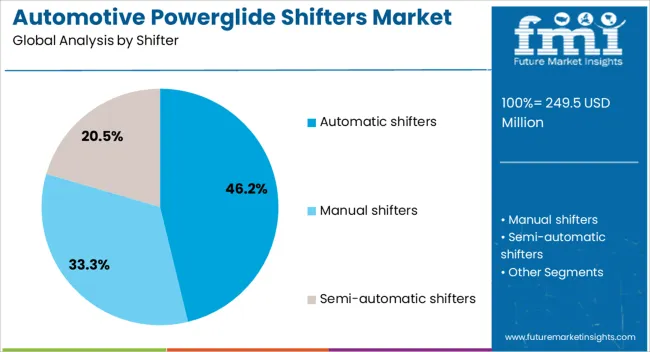
The automatic shifters segment leads the automotive Powerglide shifters market with approximately 46.2% share, driven by their extensive use in drag racing and performance builds requiring rapid, reliable gear changes. This dominance is attributed to the segment’s proven track record in handling high horsepower applications while maintaining transmission efficiency.
The preference for automatic shifters among enthusiasts stems from their ease of use, reduced driver fatigue, and ability to deliver consistent results in competitive scenarios. The segment has also benefited from ongoing innovations in shift gate designs, cable systems, and ergonomics, improving both precision and user comfort.
Their compatibility with a wide range of Powerglide transmission setups and adaptability for both street and track applications further strengthen their market position. With continued demand from performance-focused builders and racers, the automatic shifters segment is expected to maintain its lead, supported by aftermarket upgrades and sustained interest in motorsports.
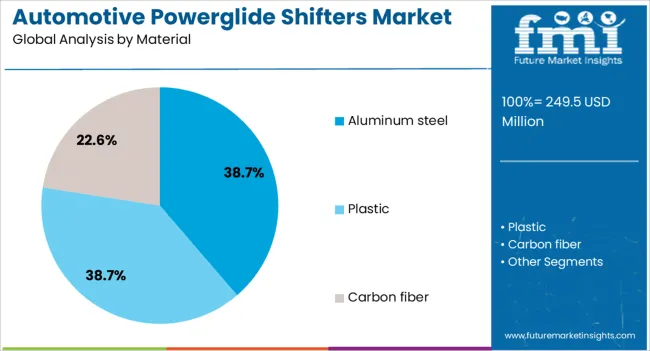
The aluminum steel segment accounts for around 38.7% of the automotive Powerglide shifters market, reflecting its balance of strength, durability, and weight efficiency. The combination of aluminum’s lightweight properties with steel’s structural rigidity offers a material advantage, enhancing both performance and longevity under extreme operating conditions. This hybrid material approach has been widely adopted to ensure resistance against wear, corrosion, and deformation, making it suitable for prolonged racing applications.
Manufacturers favor aluminum steel construction for its machinability, enabling precision engineering and customization for different vehicle setups. The cost-effectiveness of this material combination compared to fully exotic alloys further supports its market penetration.
Additionally, its widespread availability and proven performance history in motorsports applications have reinforced consumer confidence. With increasing focus on lightweight performance components and the durability needs of competitive racing, the aluminum steel segment is expected to retain a significant share in the coming years.
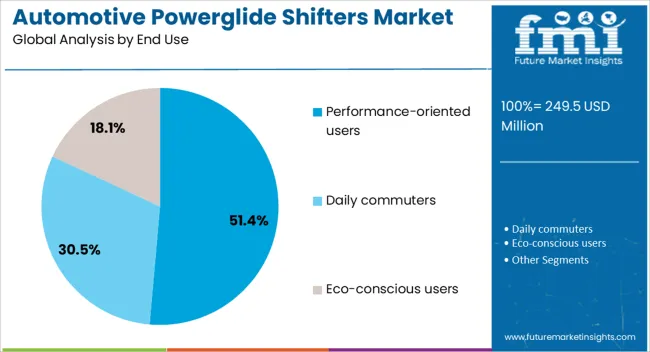
Performance-oriented users constitute the largest end-use category, holding approximately 51.4% of the market share. This dominance stems from the segment’s preference for shifters that deliver rapid engagement, minimal shift lag, and enhanced control in high-output vehicles.
Demand is largely concentrated among drag racers, muscle car restorers, and custom build enthusiasts who prioritize drivetrain responsiveness and transmission reliability. The segment’s growth has been supported by rising participation in motorsports events, increased availability of specialized aftermarket kits, and the willingness of this user base to invest in premium components for performance gains.
Performance-oriented users also influence product innovation, driving manufacturers to develop shifters with improved ergonomics, customizable settings, and higher material tolerances. As motorsport culture and performance tuning trends continue to expand globally, this segment is projected to maintain its lead, ensuring ongoing demand for high-quality Powerglide shifters in both professional and enthusiast markets.
The automotive powerglide shifters market is expanding steadily, driven by their strong adoption in drag racing, classic car restoration, and performance modification segments. North America leads with a strong motorsport culture, while Europe and Asia-Pacific follow with growing interest in racing and aftermarket customization. Key players differentiate through product durability, compatibility with racing transmissions, and precision performance. Differences in consumer preference, vehicle modification trends, and regional motorsport popularity continue to shape adoption and growth across competitive and recreational automotive markets.
Drag racing’s increasing popularity, especially in North America, significantly drives demand for automotive powerglide shifters. These shifters are valued for their reliability under extreme torque loads, simple two-speed design, and smooth performance in high-powered race cars. Europe and Asia-Pacific are also witnessing steady adoption, supported by grassroots racing events and growing aftermarket customization culture. Differences in racing infrastructure, event frequency, and consumer spending influence shifter demand across regions. Leading suppliers emphasize durability, faster gear response, and easy installation, while regional brands target affordability for hobbyists. The contrast between professional drag racing circuits and entry-level enthusiasts shapes the demand curve, ensuring both premium high-performance and cost-effective shifters maintain relevance in the global market.
Restoration of vintage and classic vehicles is another major factor sustaining demand for automotive powerglide shifters. North America, with its strong muscle car legacy, leads this segment, while Europe and Asia-Pacific increasingly adopt powerglide shifters for custom builds and collector cars. Differences arise in consumer intent: USA buyers focus on authenticity and performance upgrades, while European and Asian buyers emphasize customization for modern reliability. Leading suppliers provide both traditional-style shifters and modern variants compatible with advanced transmissions. Regional producers focus on cost-effective, adaptable options for varied vehicle models. This balance between preserving automotive heritage and introducing modern performance solutions makes restoration projects a key growth area, ensuring the market appeals to diverse segments of car enthusiasts globally.
Product differentiation in the powerglide shifters market primarily depends on durability and precision performance. North American markets prioritize premium shifters capable of handling high horsepower in competitive racing, while Asia-Pacific emphasizes affordability for hobbyists and small-scale racing teams. Europe values engineering precision and compatibility with modified vehicles for both performance and endurance events. Manufacturers compete by offering shifters with enhanced ergonomics, smooth gear transitions, and adaptable mounting solutions. Regional contrasts highlight different buying priorities: long-term reliability for professional racing, cost efficiency for entry-level users, and customization for enthusiasts. Suppliers balancing these requirements establish stronger brand loyalty, reinforcing competitiveness in the aftermarket. This contrast in performance expectations continues to influence innovations, shaping both high-end and mid-range product development.
The aftermarket ecosystem, alongside motorsport culture, strongly shapes the powerglide shifters market. In North America, a mature aftermarket supports wide availability of high-performance shifters, with partnerships between transmission specialists, racing teams, and car clubs boosting sales. Europe’s fragmented aftermarket relies more on specialized suppliers, while Asia-Pacific experiences rapid growth driven by rising car enthusiast communities and expanding racing events. Differences in aftermarket maturity, distribution channels, and customization trends directly impact adoption.
Leading suppliers integrate marketing with racing sponsorships, while regional players focus on price accessibility and affordability. This contrast ensures diverse growth opportunities, as premium brands thrive in areas with strong motorsport culture, while entry-level solutions grow in regions where customization trends are emerging. The interplay between aftermarket development and motorsport popularity ensures continued market expansion across regions.
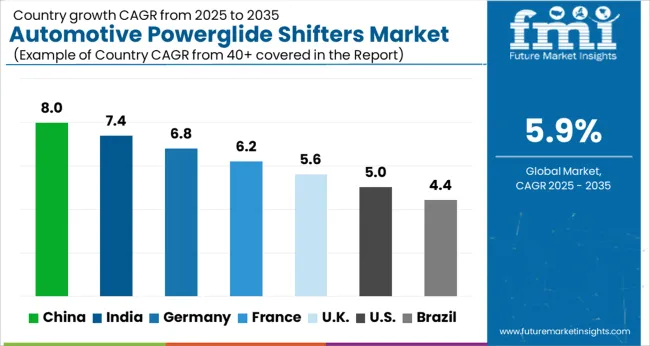
| Country | CAGR |
|---|---|
| China | 8.0% |
| India | 7.4% |
| Germany | 6.8% |
| France | 6.2% |
| UK | 5.6% |
| USA | 5.0% |
| Brazil | 4.4% |
The global automotive powerglide shifters market is projected to grow at a 5.9% CAGR through 2035, fueled by demand in performance vehicles, aftermarket customization, and transmission system upgrades. Among BRICS nations, China led with 8.0% growth as large-scale manufacturing and integration into performance automotive platforms expanded, while India at 7.4% increased domestic production and adoption across commercial and racing applications. In the OECD region, Germany at 6.8% maintained steady utilization under stringent automotive engineering standards, while the United Kingdom at 5.6% advanced moderate-scale deployment in motorsport and specialty vehicles. The USA, growing at 5.0%, sustained widespread adoption in aftermarket automotive customization and drag racing, supported by strong regulatory compliance and consumer demand. This report includes insights on 40+ countries; the top countries are shown here for reference.
The automotive powerglide shifters market in China is anticipated to record a CAGR of 8.0%, fueled by the expansion of the automotive industry, performance vehicle demand, and technological adoption. Usage is being promoted in high performance cars where precision, smooth shifting, and reliability are required. Domestic suppliers are being encouraged to provide advanced, durable, and cost-effective shifters. Distribution is being maintained through automotive parts suppliers, performance car manufacturers, and aftermarket retailers. Government initiatives supporting automotive manufacturing and consumer preference for performance upgrades are recognized as key drivers of the automotive powerglide shifters market in China.
In India, the automotive powerglide shifters market is projected to grow at a CAGR of 7.4%, supported by rising vehicle customization, growing motorsport activities, and a flourishing automotive industry. Adoption is being encouraged for shifters that ensure precision, smooth operation, and long term durability. Domestic and global suppliers are being urged to provide affordable and technologically advanced products. Distribution through performance vehicle workshops, aftermarket retailers, and automotive dealers is being expanded. Growth in motorsport participation and consumer demand for performance enhancements are considered critical to the automotive powerglide shifters market in India.
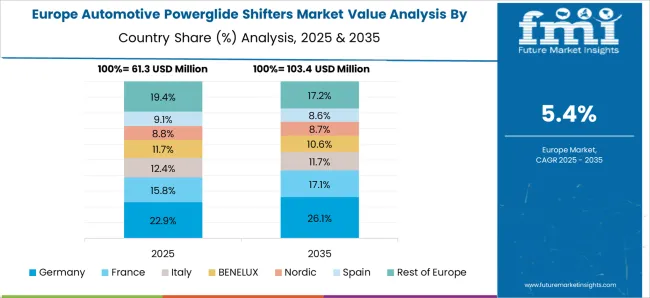
Germany is witnessing growth in the automotive powerglide shifters market at a CAGR of 6.8%, driven by strong demand from performance cars, motorsport culture, and advanced automotive engineering. Adoption is being promoted for shifters that guarantee precision, efficiency, and durability under demanding conditions. Manufacturers are being encouraged to deliver high performance, innovative, and eco friendly solutions. Distribution through premium automotive suppliers, aftermarket stores, and motorsport service providers is being strengthened. Technological advancement and engineering expertise are considered major factors influencing the automotive powerglide shifters market in Germany.
The automotive powerglide shifters market in the United Kingdom is expected to grow at a CAGR of 5.6%, supported by demand from motorsport activities, vehicle tuning, and automotive aftermarket services. Adoption is being encouraged for shifters that ensure high reliability, smooth shifting, and performance consistency. Suppliers are being urged to provide innovative, affordable, and durable products. Distribution through motorsport service providers, automotive dealers, and aftermarket retailers is being expanded. Rising popularity of vehicle modifications and motorsport events is recognized as a critical driver of the automotive powerglide shifters market in the United Kingdom.
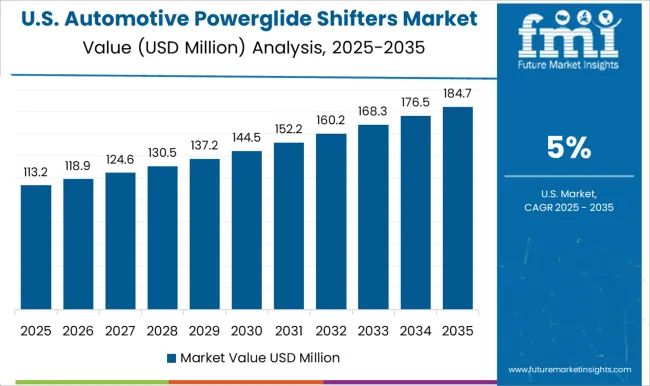
The automotive powerglide shifters market in the United States is projected to expand at a CAGR of 5.0%, influenced by motorsport culture, drag racing popularity, and widespread vehicle customization. Adoption is being promoted for shifters that offer high performance, reliability, and precision. Domestic manufacturers are being encouraged to supply advanced, cost effective, and durable products. Distribution is being supported through aftermarket suppliers, drag racing workshops, and vehicle modification centers. Enthusiasm for high performance vehicles and motorsport activities is considered a strong driver of the automotive powerglide shifters market in the United States.
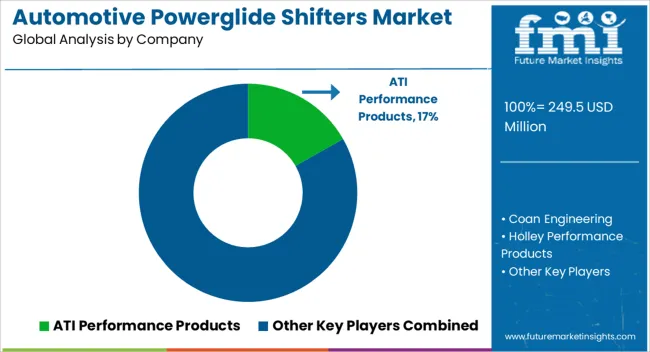
The automotive powerglide shifters market is strongly influenced by prominent suppliers who bring decades of expertise and engineering innovation to the racing and performance automotive sector. Among the most recognized names, ATI Performance Products, Coan Engineering, and Holley Performance Products stand out as key players. These companies are widely respected for their ability to design shifters that can withstand the high-stress environments of drag racing, competitive motorsports, and performance vehicle upgrades. Their products are known for precise control, consistent operation, and durability, ensuring that racers achieve smooth and reliable gear transitions under demanding conditions.
Many of these suppliers also focus on advanced manufacturing technologies and custom solutions, enabling enthusiasts and professional racers to select shifters tailored to specific performance goals. This has helped solidify their position as trusted leaders in the aftermarket automotive components sector, where quality and precision engineering are non-negotiable requirements. Other important contributors to the market include Hughes Performance, JEGS Automotive, Lokar, M&M Transmission, Outlaw Performance, TCI Automotive, and Winters Performance Products. These suppliers diversify the market by offering a wide range of options that appeal to both competitive racers and hobbyists. Their innovations extend beyond performance alone, focusing on ergonomics, ease of installation, and adaptability for different vehicle setups.
With increasing demand for customization in performance cars, these companies provide drivers with the flexibility to choose shifters that balance strength, functionality, and style. As motorsports grow in popularity and aftermarket automotive upgrades continue to attract investment, these leading suppliers are expected to play a central role in shaping future market trends. Their dedication to quality and innovation ensures that automotive powerglide shifters remain a critical component for achieving superior vehicle performance, reinforcing their importance not only in racing circuits but also in the broader performance car community worldwide.
| Item | Value |
|---|---|
| Quantitative Units | USD 249.5 Million |
| Shifter | Automatic shifters, Manual shifters, and Semi-automatic shifters |
| Material | Aluminum steel, Plastic, and Carbon fiber |
| End Use | Performance-oriented users, Daily commuters, and Eco-conscious users |
| Vehicle | Passenger cars and Commercial vehicle |
| Sales Channel | Aftermarket and OEM |
| Regions Covered | North America, Europe, Asia-Pacific, Latin America, Middle East & Africa |
| Country Covered | United States, Canada, Germany, France, United Kingdom, China, Japan, India, Brazil, South Africa |
| Key Companies Profiled | ATI Performance Products, Coan Engineering, Holley Performance Products, Hughes Performance, JEGS Automotive, Lokar, M&M Transmission, Outlaw Performance, TCI Automotive, and Winters Performance Products |
| Additional Attributes | Dollar sales vary by shifter type, including automatic, manual, and performance-based Powerglide shifters; by application, such as drag racing, aftermarket customization, and classic car restoration; by distribution channel, spanning OEMs and aftermarket; by region, led by North America, Europe, and Asia-Pacific. Growth is driven by motorsport demand, vehicle customization trends, and the durability of Powerglide transmission systems. |
The global automotive powerglide shifters market is estimated to be valued at USD 249.5 million in 2025.
The market size for the automotive powerglide shifters market is projected to reach USD 442.6 million by 2035.
The automotive powerglide shifters market is expected to grow at a 5.9% CAGR between 2025 and 2035.
The key product types in automotive powerglide shifters market are automatic shifters, manual shifters and semi-automatic shifters.
In terms of material, aluminum steel segment to command 38.7% share in the automotive powerglide shifters market in 2025.






Our Research Products

The "Full Research Suite" delivers actionable market intel, deep dives on markets or technologies, so clients act faster, cut risk, and unlock growth.

The Leaderboard benchmarks and ranks top vendors, classifying them as Established Leaders, Leading Challengers, or Disruptors & Challengers.

Locates where complements amplify value and substitutes erode it, forecasting net impact by horizon

We deliver granular, decision-grade intel: market sizing, 5-year forecasts, pricing, adoption, usage, revenue, and operational KPIs—plus competitor tracking, regulation, and value chains—across 60 countries broadly.

Spot the shifts before they hit your P&L. We track inflection points, adoption curves, pricing moves, and ecosystem plays to show where demand is heading, why it is changing, and what to do next across high-growth markets and disruptive tech

Real-time reads of user behavior. We track shifting priorities, perceptions of today’s and next-gen services, and provider experience, then pace how fast tech moves from trial to adoption, blending buyer, consumer, and channel inputs with social signals (#WhySwitch, #UX).

Partner with our analyst team to build a custom report designed around your business priorities. From analysing market trends to assessing competitors or crafting bespoke datasets, we tailor insights to your needs.
Supplier Intelligence
Discovery & Profiling
Capacity & Footprint
Performance & Risk
Compliance & Governance
Commercial Readiness
Who Supplies Whom
Scorecards & Shortlists
Playbooks & Docs
Category Intelligence
Definition & Scope
Demand & Use Cases
Cost Drivers
Market Structure
Supply Chain Map
Trade & Policy
Operating Norms
Deliverables
Buyer Intelligence
Account Basics
Spend & Scope
Procurement Model
Vendor Requirements
Terms & Policies
Entry Strategy
Pain Points & Triggers
Outputs
Pricing Analysis
Benchmarks
Trends
Should-Cost
Indexation
Landed Cost
Commercial Terms
Deliverables
Brand Analysis
Positioning & Value Prop
Share & Presence
Customer Evidence
Go-to-Market
Digital & Reputation
Compliance & Trust
KPIs & Gaps
Outputs
Full Research Suite comprises of:
Market outlook & trends analysis
Interviews & case studies
Strategic recommendations
Vendor profiles & capabilities analysis
5-year forecasts
8 regions and 60+ country-level data splits
Market segment data splits
12 months of continuous data updates
DELIVERED AS:
PDF EXCEL ONLINE
Automotive Direct Liquid Cooling IGBT Module Market Size and Share Forecast Outlook 2025 to 2035
Automotive Hoses and Assemblies Market Size and Share Forecast Outlook 2025 to 2035
Automotive Network Testing Market Size and Share Forecast Outlook 2025 to 2035
Automotive Performance Part Market Size and Share Forecast Outlook 2025 to 2035
Automotive Carbon Ceramic Brake Market Size and Share Forecast Outlook 2025 to 2035
Automotive Camshaft Market Size and Share Forecast Outlook 2025 to 2035
Automotive Stamping Industry Analysis in India Size and Share Forecast Outlook 2025 to 2035
Automotive Cylinder Liner Market Size and Share Forecast Outlook 2025 to 2035
Automotive Microcontroller Market Size and Share Forecast Outlook 2025 to 2035
Automotive Roof Rails Market Size and Share Forecast Outlook 2025 to 2035
Automotive Active Safety System Market Size and Share Forecast Outlook 2025 to 2035
Automotive Diagnostic Scan Tool Market Size and Share Forecast Outlook 2025 to 2035
Automotive Test Equipment Market Size and Share Forecast Outlook 2025 to 2035
Automotive Dynamic Map Data Market Size and Share Forecast Outlook 2025 to 2035
Automotive Green Tires Market Size and Share Forecast Outlook 2025 to 2035
Automotive E-Tailing Market Size and Share Forecast Outlook 2025 to 2035
Automotive Interior Market Forecast Outlook 2025 to 2035
Automotive Key Market Size and Share Forecast Outlook 2025 to 2035
Automotive Appearance Chemical Market Forecast and Outlook 2025 to 2035
Automotive Seating Market Forecast and Outlook 2025 to 2035

Thank you!
You will receive an email from our Business Development Manager. Please be sure to check your SPAM/JUNK folder too.
Chat With
MaRIA